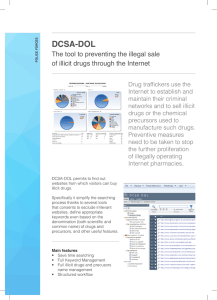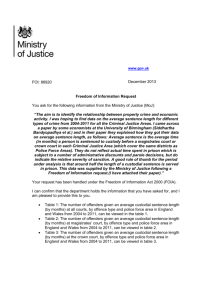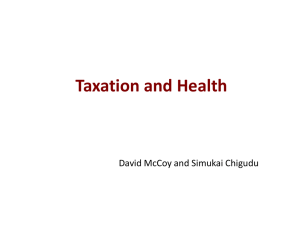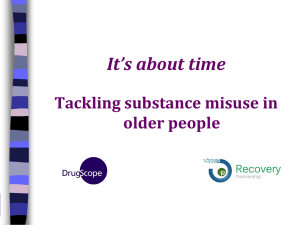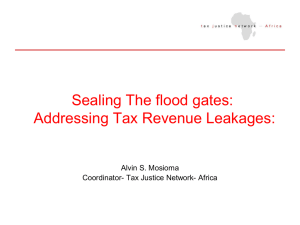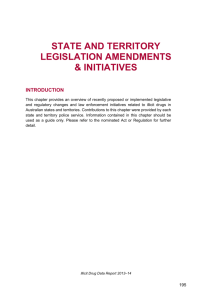State and Territory Legislative Amendments and Initiatives
advertisement
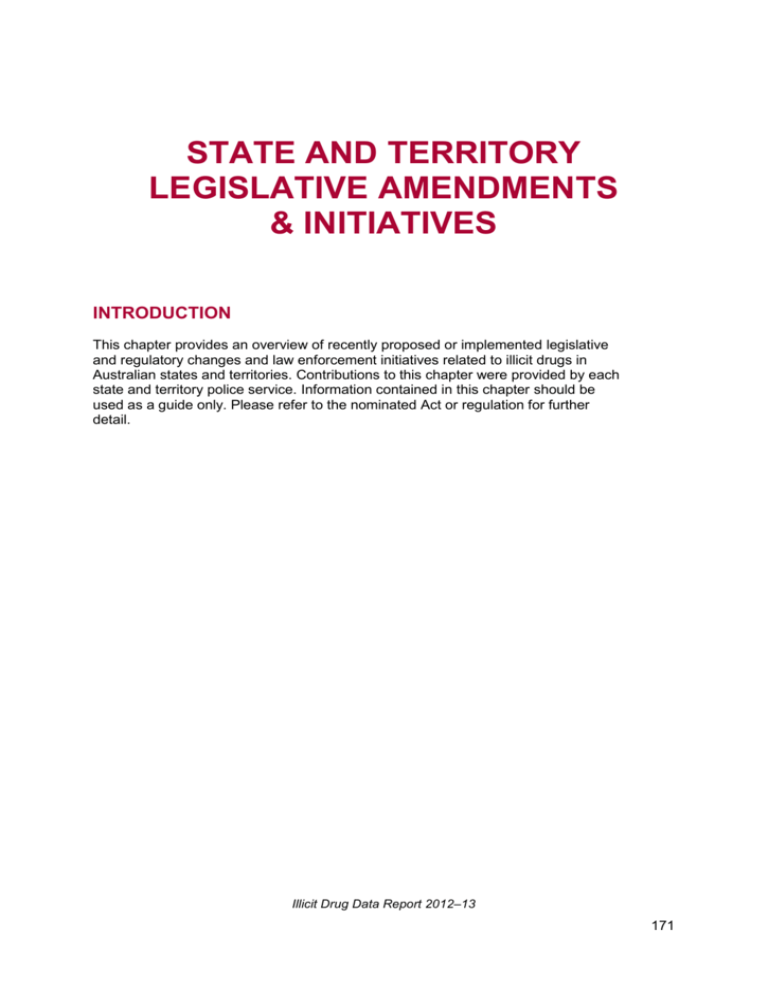
STATE AND TERRITORY LEGISLATIVE AMENDMENTS & INITIATIVES INTRODUCTION This chapter provides an overview of recently proposed or implemented legislative and regulatory changes and law enforcement initiatives related to illicit drugs in Australian states and territories. Contributions to this chapter were provided by each state and territory police service. Information contained in this chapter should be used as a guide only. Please refer to the nominated Act or regulation for further detail. Illicit Drug Data Report 2012–13 171 LEGISLATIVE & REGULATORY AMENDMENTS NEW SOUTH WALES (NSW) TITLE OF ACT/REGULATION Drug Misuse and Trafficking Act (DMTA) 1985 Date assented: 27 September 2013 PURPOSE To amend the DMTA to have 45 new substances added to Schedule 1. The substances listed in Schedule 9 of the Commonwealth Poisons Standard will be adopted into the Poisons and Therapeutic Goods Act (NSW). When new substances that belong to this class are identified, this will be specified in the DMTA Schedule and it will become a prohibited drug. OBJECTIVES The majority of synthetic cannabinoids, cathinone analogues and the NBOMe compounds will become prohibited substances. The definition of ‘analogue’ will be amended not to include the phrase ‘psychotropic properties.’ This will make it easier to prove a substance is an analogue. TITLE OF ACT/REGULATION New Psychoactive Substances Act Date assented: 24 September 2013 PURPOSE To introduce a new Act to deal specifically with psychoactive substances. OBJECTIVES Effectively this will make it an offence to sell, manufacture and advertise substances with a psychoactive effect. It will also deal with those substances that are marketed as plant food or bath salts. There will be no possession offence attached to this Act. Illicit Drug Data Report 2012–13 172 NORTHERN TERRITORY (NT) TITLE OF ACT/REGULATION Misuse of Drugs Amendment Regulations 2012 Date assented: 3 August 2012 PURPOSE The insertion of the definition ‘Indigenous community’ (regulation 6A) into section 4B(1) of the Misuse of Drugs Act. Consequently, the areas that were defined as prescribed areas under section 4 of the Northern Territory National Emergency Response (NTNER) Act 2007, prior to its repeal, are again prescribed areas under the Misuse of Drugs Act. OBJECTIVES The Regulation provides clarity of definition given the repeal of legislation. Individuals within Indigenous communities who initiate and/or aggravate certain offences may face increased penalties. QUEENSLAND (Qld) TITLE OF ACT/REGULATION Drugs Misuse Act (DMA) 1986 Date assented: 29 April 2013 PURPOSE To amend the DMA extended definition of a dangerous drug contained in Section 4 ‘Definitions’ and to create a new offence for trafficking in precursor chemicals used in the production of dangerous drugs. OBJECTIVES Amend the definition of ‘dangerous drug’ to overcome the evidentiary difficulties in proving a substance has a substantially similar chemical structure and a substantially similar pharmacological effect to a scheduled dangerous drug (where the substance is new and has not been subjected to study) to include: (c) a thing that: has a chemical structure that is substantially similar to the chemical structure of a thing referred to in paragraph (a)1 or (b)2 has a pharmacological effect that is substantially similar to the pharmacological effect of a thing referred to in paragraph (a) or (b) is intended to have a pharmacological effect that is substantially similar to the pharmacological effect of a thing referred to in paragraph (a) or (b). Additionally, create a new offence of trafficking in precursors (substances used to manufacture dangerous drugs). 1 A thing specified in the Drugs Misuse Regulation 1987, schedule 1 or 2 or, where the thing so specified is a plant, any part of the thing. 2 A thing being a salt, derivative or stereo-isomer of a thing referred to in paragraph (a) or any salt of such a derivative or stereo-isomer. Illicit Drug Data Report 2012–13 173 QUEENSLAND (Qld) cont. TITLE OF ACT/REGULATION Drugs Misuse Regulations (DMR) 1987 Date assented: 5 April 2013 PURPOSE Addition of 33 substances as dangerous drugs. OBJECTIVES Addition of one compound into Schedule 1 of the DMR: paramethoxymethamphetamine (PMMA). Addition of 33 compounds into Schedule 2 of the DMR: n-(1-adamantyl)-1-pentyl-indazole-3-carboxamide (APINACA or AKB48) alpha-pyrrolidinovalerophenone (alpha-PVP) 2-aminoindane 6-(2-aminopropyl)benzofuran (6-APB) butyl-3-(2-methoxybenzoyl)indole (RCS-4(C4) 2-methoxy isomer) [3-(3-carbamoylphenyl)phenyl] n-cyclohexylcarbamate (URB-597) cyclohexyl [1,1'-biphenyl]-3-ylcarbamate (URB-602) desoxypipradrol (2-DPMP) 1,3-dimethylamylamine (DMAA or methylhexanamine) 1-(5-fluoropentyl)-3-(1-adamantylamido)indole (STS-135) (1-(5-fluoropentyl)-indol-3-yl)-(2,2,3,3-tetramethylcyclopropyl) methanone (XLR-11; 5-fluoro UR-144) 1-(5-fluoropentyl)-3-(4-methyl-1-naphthoyl)indole (5-fluoro JWH-122) 5-hydroxy tryptophan (5-HTP) 4-hydroxy-n-methyl-n-ethyltryptamine (4-HO-MET) methiopropamine methoxetamine n-(2-methoxybenzyl)-2,5-dimethoxy-4-bromophenethylamine (25B-NBOMe) n-(2-methoxybenzyl)-2,5-dimethoxy-4-chlorophenethylamine (25C-NBOMe) n-(2-methoxybenzyl)-2,5-dimethoxy-4-iodophenethylamine (25I-NBOMe) 5-methoxy-n,n-diallyltryptamine (5-MeO-DALT) 5,6-methylenedioxy-2-aminoindane (MDAI) 3,4-methylenedioxypyrovalerone (MDPV) 4-methylethylcathinone (4-MEC) Illicit Drug Data Report 2012–13 174 1-[(n-methylpiperidin-2-yl)methyl]-3-(1-adamantoyl)indole (AM-1248) 1-[(n-methylpiperidin-2-yl)methyl]-3-(2-iodobenzoyl)indole (AM-2233) 1-[(n-methylpiperidin-2-yl)methyl]-3-(4-methyl-1-naphthoyl)indole (MAM-1220) 1-[(n-methylpiperidin-2-yl)methyl]-3-(1-naphthoyl)indole (AM-1220) naphthylpyrovalerone (naphyrone) pentyl-3-(1-adamantoyl)indole (AB-001) pentylindol-3-yl)-(2,2,3,3-tetramethylcyclopropyl)methanone (UR-144) pentyl-3-(2-methoxybenzoyl)indole (RCS-4 (2-methoxy isomer)) phenazepam. TASMANIA (Tas) TITLE OF ACT/REGULATION Misuse of Drugs Order 2012 Date assented: 1 October 2012 PURPOSE The Order enabled the addition of synthetic cannabinoid drug classes and other new substances to the Controlled Drug list of the Misuse of Drugs Act 2001. OBJECTIVES To increase the utility of the Act to deal with new psychoactive substances. Illicit Drug Data Report 2012–13 175 WESTERN AUSTRALIA (WA) TITLE OF ACT/REGULATION Misuse of Drugs Amendment Act 2011 Date assented: 30 January 2013 PURPOSE To amend the Misuse of Drugs Act 1981 to change the definition of drug paraphernalia and to create a number of new offences concerning the sale and display for sale of drug paraphernalia. OBJECTIVES Drug paraphernalia is now defined as: a) anything made or modified to be used in connection with manufacturing or preparing a prohibited drug or a prohibited plant: for administration to a person for smoking, inhaling or ingesting by a person to be burned or heated so its smoke or fumes can be smoked or inhaled by a person. b) anything made or modified to be used by a person: to administer a prohibited drug or a prohibited plant to a person to smoke, inhale or ingest a prohibited drug or prohibited plant to smoke or inhale the smoke or fumes resulting from burning or heating a prohibited drug or prohibited plant. Illicit Drug Data Report 2012–13 176 STATE AND TERRITORY INITIATIVES AUSTRALIAN CAPITAL TERRITORY (ACT) INITIATIVE Early Intervention and Diversion Program (Alcohol Diversion for Young People) and the Illicit Drug Diversion Program DURATION 2010–2012 MAIN OBJECTIVES AND/OR OUTCOMES The Australian Capital Territory Policing Early Intervention and Diversion program is designed to provide early incentives for drug offenders to deal with their drug problems. The main people who can benefit from this program are young offenders who have no prior involvement with the courts. Young drug offenders who qualify for the program have the opportunity of being referred to a variety of education and treatment options. It is a partnership approach between health, police and non-government agencies adhering to the principles of the National Drug Strategy 2010–2015. NEW SOUTH WALES (NSW) INITIATIVE End User Declarations (EUD) DURATION 2010–2013 MAIN OBJECTIVES AND/OR OUTCOMES An electronic system should be developed in order to facilitate the input and retrieval of this data. The New South Wales Police Drug Squad has made a submission to create such a system and there is currently a study funded by the National Drug Law Enforcement Research Fund (NDLERF) looking at the feasibility of such a system. Price Waterhouse Coopers has finished their scoping study and presented their results. NDLERF has accepted and endorsed the scoping study. The study has been adopted by the Australia New Zealand Policing Advisory Agency Crime Forum and has now been endorsed by the Strategic Issues Group (CrimTrac) and Senior Officers Group on Organised Crime. The Investigations Coordinator Chemical Operations (New South Wales Police Force) will chair the EUD Working Group and with the Attorney General’s Department will identify and formalise other jurisdictional members of the working group. Illicit Drug Data Report 2012–13 177 NEW SOUTH WALES (NSW) cont. INITIATIVE Pharmaceutical misuse DURATION 2010–2013 MAIN OBJECTIVES AND/OR OUTCOMES The New South Wales Police Force (NSWPF) are currently involved in a range of external committees that are looking at pharmaceutical misuse including the Intergovernmental Committee on Drugs (IGCD), New South Wales Expert Advisory Group on Drugs and the New South Wales Illicit Drug and Alcohol Monitoring Group. The IGCD commenced the National Pharmaceutical Drugs Misuse Strategy in 2010.The aim of the strategy is to reduce the diversion and misuse of pharmaceuticals and associated harms. The NSWPF have contributed to the consultation process for the Strategy through participation in the New South Wales consultation forum and through the provision of research into the illicit pharmaceuticals market conducted by the Drug and Alcohol Coordination (DAC). Some of the key issues for law enforcement agencies include accurate police data collection, information sharing between state and federal police and health bodies, sharing and development of best practice strategies in relation to prosecutions and health initiatives, a review of relevant jurisdictional laws and regulations, clear delineation of regulator roles, responsibility and liaison channels, a real-time national on-line prescription system and education programs and resources for all stakeholders. The NSWPF is committed to pursuing operational and policy responses to these issues through an internal working party consisting of DAC, the Drug Squad and Local Area Command members. This working party will facilitate change within the NSWPF and through membership to external bodies including the IGCD. NORTHERN TERRITORY (NT) INITIATIVE Northern Territory Early Intervention Pilot Program (NTEIPP) DURATION 2010–2013 MAIN OBJECTIVES AND/OR OUTCOMES The NTEIPP aims to facilitate partnerships with police, community service organisations and agencies, with a view to better engage with youth. Facilitating an interventionist approach enables youth to engage positively with community based police and other organisations and be provided with opportunity for referral and brief interventions. The improved relationships developed with youths through use of the NTEIPP have fostered a connection to health and other social services. This positive interaction with young people facilitates the intervention and referral process. Illicit Drug Data Report 2012–13 178 NORTHERN TERRITORY (NT) cont. INITIATIVE Northern Territory Illicit Drug Pre Court Diversion Program (IDPCDP) DURATION Ongoing-current MAIN OBJECTIVES AND/OR OUTCOMES The Northern Territory IDPCDP model enables police to divert first time drug offenders (both juvenile and adults) in possession of less than a trafficable quantity of an illicit drug. These offenders may be given the opportunity to participate in assessment, education, counselling and/or treatment to expiate the offence. Non-compliance in assessment or intervention results in the offender being prosecuted through the court system. This program utilises and enhances service provision, provided by both Government and non-government organisations, to maximise the opportunity for users of illicit drugs and licit drugs (used illicitly) to enter assessment, education, counselling and/or treatment. It establishes a framework whereby users may, through the admission of guilt, be diverted by police to assessment, education, counselling and/or treatment as an alternative to receiving a criminal penalty. QUEENSLAND (QLD) INITIATIVE Clandestine Laboratory Awareness Workshops – CLAWS project DURATION 2012–2013 MAIN OBJECTIVES AND/OR OUTCOMES The aim of this project was to educate real estate professionals state-wide, with a view of increasing awareness to identify the presence of a clandestine laboratory and thereby minimising the risk of harm to the community, whilst ensuring property security and integrity. The project also aimed to educate the Department of Communities in relation to clandestine laboratory investigation. INITIATIVE Operation Greensmoke (synthetic drug awareness) DURATION 2013 MAIN OBJECTIVES AND/OR OUTCOMES The aim of this project was to educate police, industries (such as the mining sector) and the community throughout metropolitan and regional Queensland about the new and emerging drugs such as synthetic cannabis and ‘bath salts’. Illicit Drug Data Report 2012–13 179 QUEENSLAND (QLD) cont. INITIATIVE National Drug Commander’s Forum DURATION 2013 MAIN OBJECTIVES AND/OR OUTCOMES The Queensland State Drug Squad (SDS) hosted the 2013 National Drug Commander’s Forum which was held on 13 November 2013 in Cairns. The theme of the forum was ‘Bridging the Borders’ and focused on developing strategies to enhance cross-jurisdictional cooperation in drug related investigations involving police and other law enforcement agencies throughout Australia. Commanders of drug units are required to address a variety of shifting organisational and governmental priorities with a limited amount of resources, whilst remaining cognisant of the need to maintain the guidelines set by national and state drug policies. The National Drug Commander’s Forum provided an opportunity to address the recurring issues of crossborder operations, use of proceeds of crime funds for operations, unexplained wealth and other topics where jurisdictional differences impede the progress of operational outcomes. Representatives from a national, state and territory police and other law enforcement and partner agencies attended the forum which included the United States Federal Bureau of Investigation, the United States Drug Enforcement Administration, the New Zealand Police, Netherlands Police, the Australian Crime Commission, the Australian Customs & Border Protection Service, the Crime and Misconduct Commission and the Australian Sport AntiDoping Agency. The forum and seminar was made possible thanks to the ongoing support of the Queensland Police Service State Crime Command, the Drug and Alcohol Coordination Unit and the Australian Crime Commission. Illicit Drug Data Report 2012–13 180 SOUTH AUSTRALIA (SA) INITIATIVE South Australian Alcohol and Other Drug Strategy 2011–2016 – Annual Report on Progress DURATION November 2011–2012 MAIN OBJECTIVES AND/OR OUTCOMES The first progress report of the 2011–2016 Strategy was prepared by Drug and Alcohol Services South Australia, with input from lead agencies, including South Australia Police, through the South Australian Alcohol and Other Drug Strategy Steering Group. The first year of the strategy delivered significant progress. Of 60 priority actions, 56 are on track or complete, 4 require additional effort and there are none behind schedule or not expected to be met. INITIATIVE Naloxone Distribution Pilot Program DURATION November 2012–May 2014 MAIN OBJECTIVES AND/OR OUTCOMES An 18-month Naloxone Distribution Pilot Program implemented by Drug and Alcohol Services South Australia is the first of its kind in South Australia. It is overseen by an advisory group comprised of representatives from police, ambulance, clinical services, SA Voice for Intravenous Education, SA Sex Industry Network and the Expanding Naloxone Availability in ACT committee. The pilot program aims to: increase availability of naloxone to people who inject opioids increase the capacity of people who inject opioids and potential overdose witnesses to effectively respond to an opioid overdose reduce brain injury and fatalities caused by opioid overdoses. By June 2013, overall parameters and methodology were being reassessed due to difficulties achieving recruitment targets despite augmentation strategies. Illicit Drug Data Report 2012–13 181 SOUTH AUSTRALIA (SA) cont. INITIATIVE South Australia Police Illicit Drug Strategy 2012–2016 DURATION 2012–16 MAIN OBJECTIVES AND/OR OUTCOMES In September 2012, the South Australia Police Illicit Drug Strategy 2012–2016 was launched as a succinct document that emphasises every action counts when addressing the complexities of illicit drug use and related crime. It is overseen by a management group of senior executives and the managers of relevant specialist units. With emergent technological advances and exponential growth of online purchasing, innovation is required to effectively address internet use for purchasing and distribution of illicit drugs, their clandestine manufacture and the importation of analogue and synthetic drugs. Police officers have a vital role for increasing illicit drug detections and positively influencing community attitudes towards illicit drugs by focusing activities on the four priority areas of the Strategy: enforcement partnerships and community engagement capacity building intelligence analysis and research. TASMANIA (Tas) INITIATIVE Illicit Drug Diversion Initiative (IDDI) DURATION 2000–ongoing In 2011, the IDDI became a program for adults only. MAIN OBJECTIVES AND/OR OUTCOMES The IDDI is an early intervention program for minor drug offenders, where cannabis and other illicit drugs are involved, including the illicit use of pharmaceuticals. IDDI operates under an agreement between the Department of Police and Emergency Management and the Department of Health and Human Services (DHHS). The IDDI seeks to divert minor drug offenders away from the criminal justice system. An offender may be issued with a caution or a diversion notice. A diversion notice requires that the individual make contact with the Alcohol Drug Service (ADS), DHHS. The ADS provides assessment, counselling and treatment to assist minor drug offenders to address their drug use issues. Illicit Drug Data Report 2012–13 182 TASMANIA (Tas) cont. INITIATIVE Tasmanian Psychostimulants Action Plan 2007–2013 DURATION 2007–2013 MAIN OBJECTIVES AND/OR OUTCOMES The Tasmanian Psychostimulants Action Plan 2007–2013 was developed by the Inter Agency Working Group on Drugs (IAWGD) and was launched in 2007. The IAWGD is a group that has representation from a range of government departments and non-government organisations. The IAWGD is also responsible for implementation, monitoring and reporting against the Plan. The objectives of the Tasmanian Psychostimulants Action Plan 2007–2013 are to: reduce the supply and availability of illicit drugs and precursors work with the dance party industry to develop guidelines for safer environments build resilience in young people develop information resources for young people, the community, police and health professionals provide timely and appropriate intervention and linking of people to health services. The Plan supports the objectives of the Tasmanian Drug Strategy 2005–2012. Illicit Drug Data Report 2012–13 183 TASMANIA (Tas) cont. INITIATIVE Court Mandated Diversion (CMD) DURATION Ongoing-current MAIN OBJECTIVES AND/OR OUTCOMES CMD provides Magistrates with an option to divert eligible offenders into treatment for their drug use through either the bail or sentencing process. CMD is administered by the Department of Justice. The primary goal of the CMD program is to break the drug-crime cycle by involving offenders in treatment and rehabilitation programs. It increases offender access to drug, alcohol, and other welfare services, in order to break their cycle of contact with the criminal justice system. Other principal goals of the CMD project are to: provide offenders with an opportunity to acknowledge and address offending behaviour caused by drug abuse, thereby improving physical and psychological well being help eligible offenders to reduce and abstain from illicit drug use reduce drug-related offending behaviour improve offenders’ relationships with family and friends improve offenders’ possibility of gaining or retaining employment provide offenders with the tools to recognise and prevent relapse into substance abuse and criminal behaviour develop a shared approach to and a commitment to a ‘joint’ service delivery system between Government and the non-government sector. Illicit Drug Data Report 2012–13 184 VICTORIA (Vic) INITIATIVE Illicit Drug Diversion Initiative DURATION Ongoing-current MAIN OBJECTIVES AND/OR OUTCOMES The Drug Diversion and Cannabis Cautioning programs enable police to refer illicit drug users to timely health interventions. The Cannabis Cautioning program involves providing a cautioning notice for simple use/possess cannabis offences to offenders who meet the police criteria. An optional education session for offenders will be offered in conjunction with the caution. The Drug Diversion program involves offering a diversion to a person detained for use or possession of an illicit drug other than cannabis on the condition that they undertake a clinical drug assessment and enter any prescribed drug treatment. The offender must meet police criteria and agree to the diversion and will be provided with a drug assessment appointment time. Illicit Drug Data Report 2012–13 185
